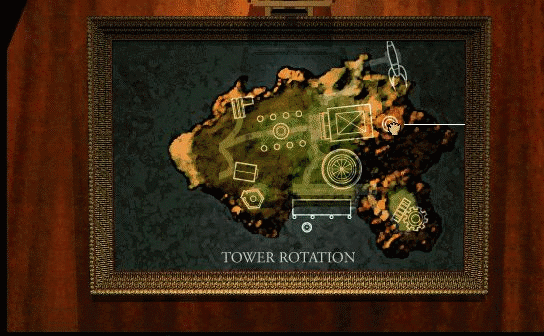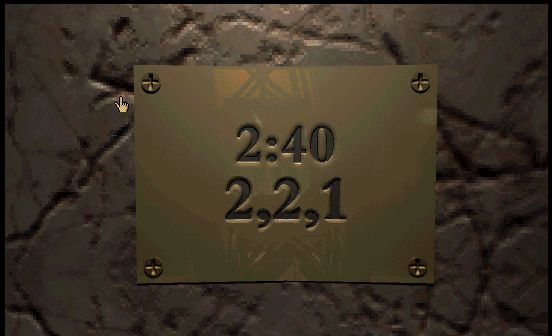 |
| I used to watch this all day. Weee! |
For this, I'll be going simply by order of which object is
locked onto first as the tower rotates, which is the gears.
So, supposing the player chooses the gears, then goes up the
tower and gets a small view of the gears.
Heading to the other side, the player will notice a plaque with the
vague clues:
 |
| Credit where credit is due, lparchive.org has a great little walkthru with many of these pics. |
Naturally, clock towers are full of gears. Hopefully the player will catch the theme,
and instead of heading for the gears, will instead head for the clock tower.
When the player changes the time to 2:40, gears from the
ocean will emerge, allowing the player to cross (and while they're at it, flip
the final marker switch for kicks).
The clock puzzle basically gives the player the answer in
the rotating tower, but it is the understanding of where to use the code that
is the true puzzle.
This kind of puzzle, where the answer cannot be guessed or
figured out, but rather given, is often the building block to many terrible
"Escape the Room" games, a subgenre of Adventure. It is unfortunate that so many of these games
don't provide the challenge of these puzzles, because instead of having to
figure out where to input the code,
even that is obvious.
 |
| Possibly the inspiration for "Saw". |
Once the player enters the clock tower, s/he is met with the
second puzzle, a puzzle of gears and levers, and it is here the player will
probably understand that the three numbers in the tower clue are the solution
to this puzzle, simply because the gears are demanding three numbers.
Trial and error teaches the player the controls, and
eventually the player figures out how to get to the solution. This puzzle is more of a traditional puzzle,
in that it is self-contained and the player may feel as though they are
"stuck" on one screen until it is solved.
Two puzzles in a row; of two completely different kinds, and
they appear at the opposite end of the island than the player intended to go.
Yet, when the second puzzle is solved, a display gear in the
clock tower mimics what the larger gear outside by the dock is actually
doing. The player may understand this,
or may need to explore and find their way back to the gear to discover that the
miniature is a copy of the actual.
Miniatures or facsimiles representing larger objects is a
common theme in MYST, and after understanding one, the player will probably
realize the theme and understand intuitively from then on.
Once the player hightails back to the large gears, s/he will
find the book to the Mechanical Age. The
player may come to understand Atrus' message now about how the books are hidden
in "places of protection."
Certainly, solving two puzzles on the wrong side of the island, plus
understanding the rotating tower is plenty of protection.
The player views a flyby of the Mechanical Age, similar to
the one from opening the MYST book at the beginning of the game. If the player has read the journals in the
library, the fortress should look familiar, and the player may pause to revisit
that journal and take notes. Otherwise
(or afterward), the player will plunge into it, and explore a new island.
The player may expect from the journal entries that these
other ages will be populated, since Atrus discusses interactions with natives in
his journals.

No comments:
Post a Comment